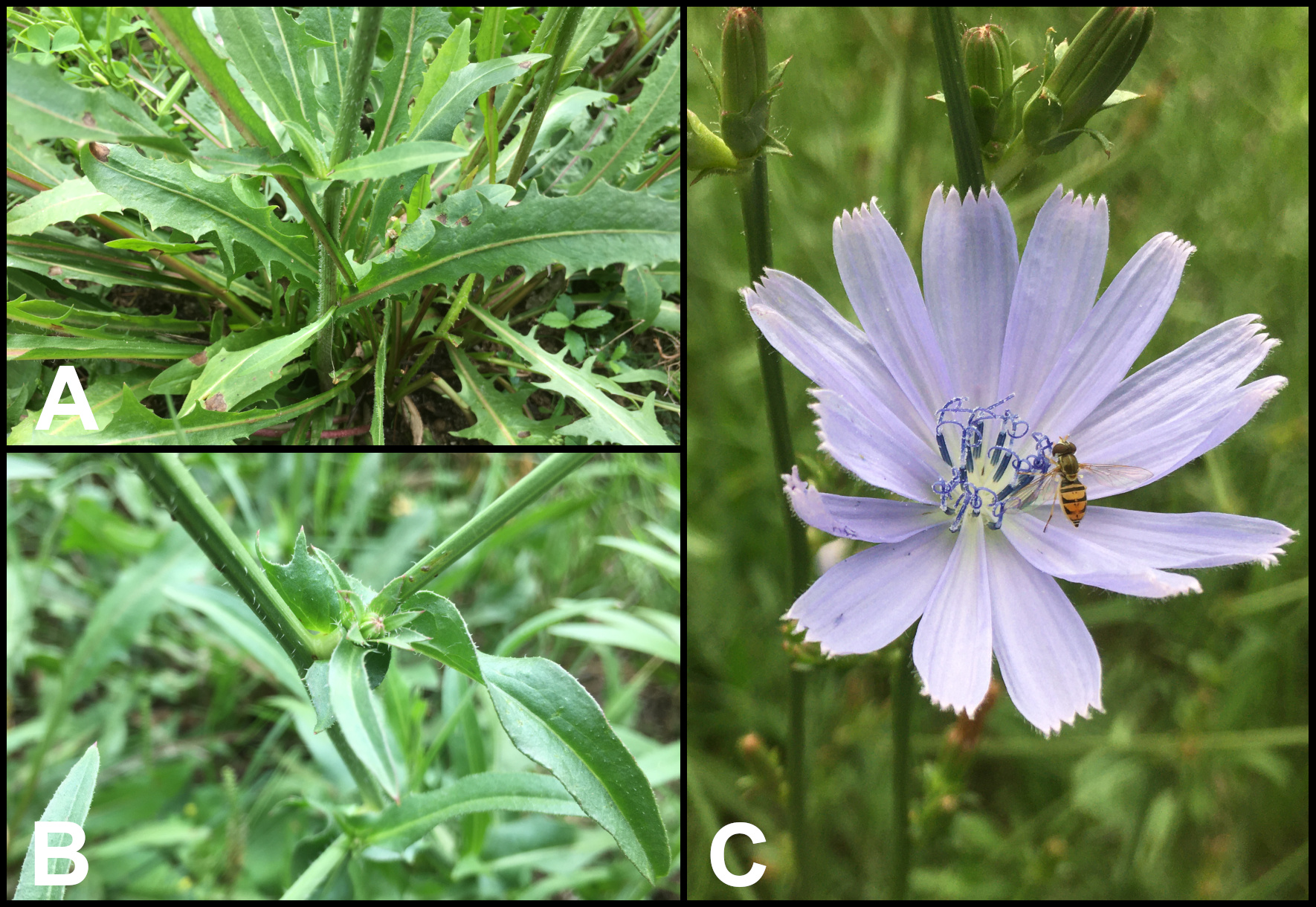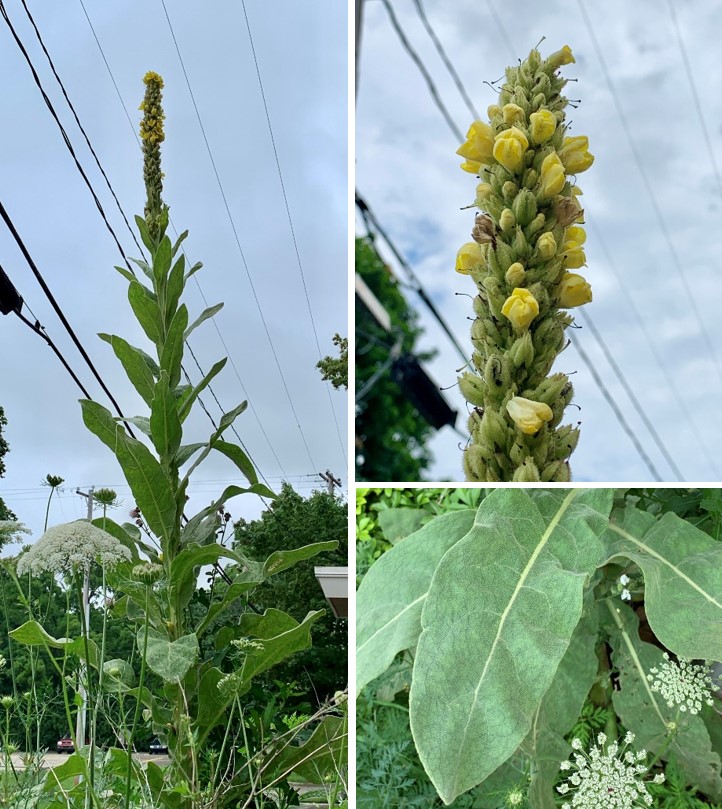Drive-by botany: Chicory and common mullein
Profiles of common Michigan roadside flora in mid-July 2021.

Authors’ note: Drive-By Botany is a continuing series that highlights flowering plants commonly seen from the road. As a service to new readers, we include the introduction with each article. If you're already familiar with the premise, feel free to skip down to the good stuff.
Has a patch of flowers ever caught your eye as you travelled down the road? It certainly happens to us all the time! As gardeners and naturalists, we're always interested increasing functional diversity in our gardens and landscapes, so we thought it would be fun to consider some of the roadside plants that we see every day. Each article in this series will feature two plant species that are currently blooming and frequently observed from the road. Our goal is to answer two simple questions:
- What are they?
- Would they make good garden plants?
As part of the process, we'll include some biological tidbits and a few useful characteristics for identification. Please note that some of the plants we feature are exotic invasive species; we'll be sure to include recommendations from land management professionals on how to manage them in your landscape.
July 2021 - week 30, growing degree days (GDD) 3,468 base 32, East Lansing, Michigan
Chicory (Cichorium intybus)
Common names: wild endive, blue sailors, coffee weed, succory, cornflower, blue daisy, bunk, and more.
Chicory is a member of the Asteraceae, a large group of plants known commonly as the daisy, sunflower, aster or composite family. The predominate characteristic of the aster family is the arrangement of their flowers. What we might perceive as a single flower is actually a flower head composed of many tiny flowers (florets).
In most cases, the flower head consists of two types of florets: disc flowers and ray flowers. Disc flowers, when present, compose the circular button-like area in the center of the flower head (also known as the disc). Ray flowers are arranged around the perimeter of the center area and have long petals that are fused together. These fused petals often appear as a single petal on the larger flower head. The prevalence of this particular arrangement of floral structures is why this group is often referred to as the composite family.
Description
Flowers: Chicory flowers are usually a bright cornflower blue, although it is possible to encounter white, pink and purple flowers occasionally. The flower head consists entirely of ligulate florets (a variation on the ray flower), each with five petals fused together, and lacks disc flowers. The five tips of each individual floret petal are highly visible, which gives the end of fused petal structure a square and toothy appearance (Photo 2). Flower heads usually measure 1-1.75 inches in diameter.
Leaves: Chicory begins the season as a basal rosette and looks nearly identical to dandelion. The basal leaves are long, coarsely toothed and somewhat lance shaped. Leaves on the flower stems are much smaller and sparsely distributed; the margins may have small teeth but often appear smooth.
Seeds/fruit: Seeds are wrapped in a wedge-shaped fruit pod almost like a bouquet. With closer inspection, one can see the little papery ends of seeds poking out from the top.

Distribution: Cichorium intybus has been documented in 67 counties within Michigan. It will grow in a variety of habitats, provided that frequent disturbance is the norm. It seems truly at home in the harsh, frequently disturbed environment along our roads and highways.
Blooming period: In Michigan, one can see chicory blooming from early July into early autumn—a relatively long window for a wild species.
Native status: Exotic/introduced. This species is not native to the United States. It was first recorded in Michigan in 1840 and has since become naturalized.
Garden uses: Chicory is a perennial species that can be useful in both ornamental and vegetable gardens. Across the world, chicory root has a long history of being used as a coffee substitute or for adding a coffee-like flavor to culinary dishes and fermented beverages. The leaves are also edible and are harvested and prepared in the same manner as dandelion leaves. Chicory can be planted as forage for livestock.
From an ornamental perspective, it's all about the flowers. The scarcity of foliage on the stem gives the plant a gangly appearance. That being said, we can see great potential for this plant when paired with some of our shorter native grasses (e.g., little bluestem) to cover up the lack of leaves. Large drifts of blooming chicory are stunning.
Management: Chicory is known to be weedy in some situations but is not often considered a big problem in agricultural or natural ecosystems. Like dandelions, it is resistant to mowing. Because of its large taproot, however, chicory does not tolerate tilling and other similar activities very well.
Common look-alikes: The basal rosettes of dandelion and chicory are nearly identical. It becomes easy to differentiate the two once the plants begin to flower.
Common mullein (Verbascum thapsus)
Driving along the road, the first thing you will probably notice about common mullein is its height. It towers above other plants with its upright spike-like stem that reaches 5 to 10 feet and is topped with yellow flowers in mid-summer. Mirroring that tall spike is a deep tap root underground.
Common mullein is a biennial that spends the first year as a basal rosette of leaves and then produces a flowering stem the following year. After flowering, the plant will die. Upon closer inspection, you may also notice the wooly leaves that gave way to another common name: flannel plant. It is a member of the Scrophulariaceae, or figwort, family.
Description
Flowers: Yellow, sessile blooms borne on a terminal spike. Flowers have five fused petals and are usually about 1 inch in diameter.
Quick definition: Sessile means attached directly without a supporting stalk.
Leaves: Alternately arranged along the stem. Oblong to lanceolate shaped and blue-gray green in color. Covered in small hairs that give a wooly appearance and 4 to 16 inches long.
Stem: Erect and covered in dense hairs. Once the plant dies after flowering, you can often still see the tall stem persisting upright through winter.
Seeds/fruit: Fruit are oval capsules covered in dense hairs. They split open when mature to release seeds. Common mullein reproduces by seed and one plant can produce over 100,000 seeds.
Height: Reaches 5 to 10 feet at maturity.

Distribution: Common mullein is widespread and has been documented in 74 Michigan counties. It can be found on disturbed sites such as roadsides, near rail roads, filled land, vacant lots, clearings as well as shores and open banks.
Blooming period: The flowers open a few at a time on the stalk from mid-summer into late summer/fall.
Native status: Exotic/introduced. This species is native to Asia and Europe.
Garden uses: Common mullein was historically planted as a medicinal herb. After introduction in the United States, it has escaped cultivation and is now a common road-side sight. You may have also heard this plant referred to as “Cowboy’s Toilet Paper” due to the plush-looking leaves that seem as close as you can get to the real toilet paper in nature. However, the small hairs that cover the leaves can break off and cause skin irritation. So, best to just admire those leaves with your eyes.
Common look-alikes: Moth mullein (Verbascum blattaria).
Questions? Feel free to contact Jeremy Jubenville or Isabel Branstrom with the Michigan State University Extension landscape team.
Thank you to Tyler Bassett from the Michigan Natural Features Inventory for his review of this article.
Resources
- Michigan Flora (2001) – E. Voss
- Weeds of the Northeast (1997) – Uva, Neal, and DiTomaso
- Edible Wild Plants (2009) – Elias & Dykeman



 Print
Print Email
Email





